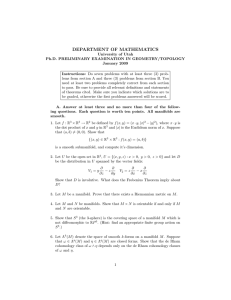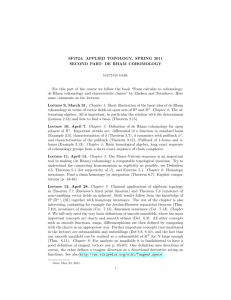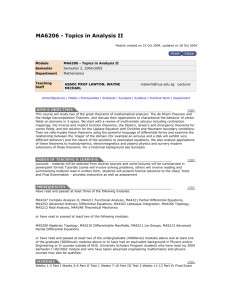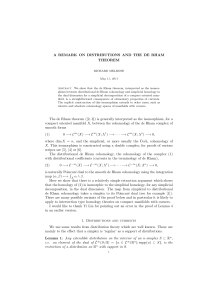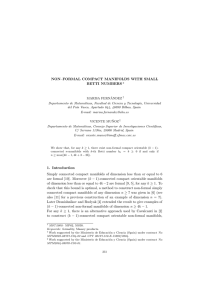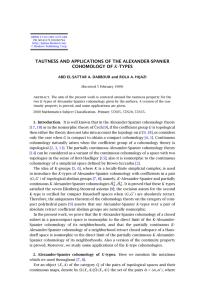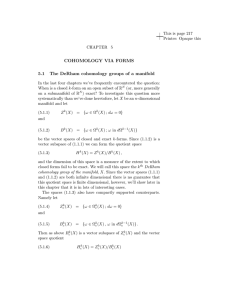Rough notes for Maths 543 Lecture 9
advertisement
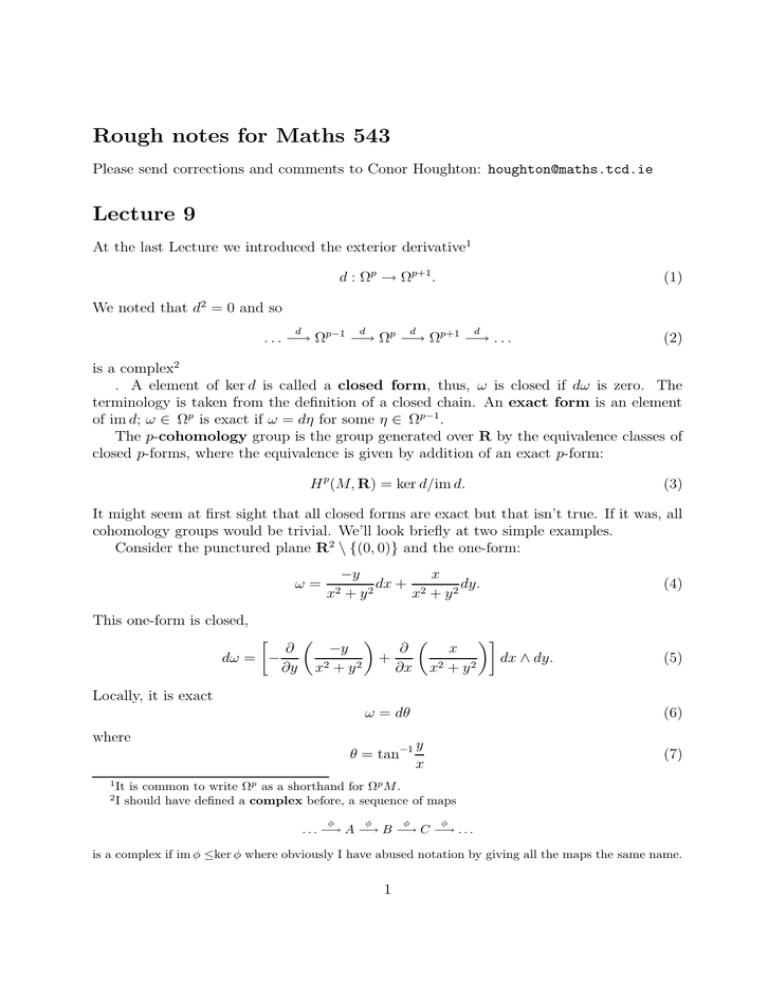
Rough notes for Maths 543
Please send corrections and comments to Conor Houghton: houghton@maths.tcd.ie
Lecture 9
At the last Lecture we introduced the exterior derivative1
d : Ωp → Ωp+1 .
(1)
We noted that d2 = 0 and so
d
d
d
d
. . . −→ Ωp−1 −→ Ωp −→ Ωp+1 −→ . . .
(2)
is a complex2
. A element of ker d is called a closed form, thus, ω is closed if dω is zero. The
terminology is taken from the definition of a closed chain. An exact form is an element
of im d; ω ∈ Ωp is exact if ω = dη for some η ∈ Ωp−1 .
The p-cohomology group is the group generated over R by the equivalence classes of
closed p-forms, where the equivalence is given by addition of an exact p-form:
H p (M, R) = ker d/im d.
(3)
It might seem at first sight that all closed forms are exact but that isn’t true. If it was, all
cohomology groups would be trivial. We’ll look briefly at two simple examples.
Consider the punctured plane R2 \ {(0, 0)} and the one-form:
ω=
−y
x
dx + 2
dy.
2
+y
x + y2
(4)
x2
This one-form is closed,
∂
dω = −
∂y
−y
2
x + y2
∂
+
∂x
x
2
x + y2
dx ∧ dy.
(5)
Locally, it is exact
ω = dθ
where
θ = tan−1
1
2
(6)
y
x
(7)
It is common to write Ωp as a shorthand for Ωp M .
I should have defined a complex before, a sequence of maps
φ
φ
φ
φ
. . . −→ A −→ B −→ C −→ . . .
is a complex if im φ ≤ker φ where obviously I have abused notation by giving all the maps the same name.
1
but θ is not a function on R2 \ {(0, 0)}; it is only single valued on a cut plane, R2 \ {the
x1 -axis} for example. Furthermore, if there is some other η such that ω = dη then dη = dθ
and this means that η and θ only differ by a constant. We can see from this that ω
generates a non-trivial class in H 1 (R2 \ {(0, 0)}). In fact, H 1 (R2 \ {(0, 0)}) = R.
The second simple example is the two-torus. As we discussed, a model for the torus
is a rectangle in the plane with opposite edges identified.3 Now, dx1 and dx2 are closed
one-forms on the torus. Neither is exact since, with the identifications, neither x1 nor x2
is single valued on the parallelogram. In fact, it turns out that H 1 (T 2 ) = R ⊕ R.
In the case of the punctured plane there is a closed form that is not exacted. There
is also a non-contractible loop. In the case of the torus, there are two non-cohomologous
closed forms, there are also two non-homologous cycles. These are examples of a more
general relationship between homology and cohomology: they are dual to each other. To
study this duality we first need to discuss integration on manifolds.4
Integration on manifolds
We begin with a standard p-simplex, σp . It is the simplex with vertices
x0 = (0, 0, . . . , 0)
x1 = (1, 0, . . . , 0)
..
.
xp = (0, 0, . . . , 1).
(8)
On the simplex any p-form can be written
ω = f dx1 ∧ . . . dxp .
We define
Z
ω=
σp
Z
f dx1 dx2 . . . dxp
(9)
(10)
σp
In other words, it is easy to define integration on a standard simplex because there are
coordinates.
A singular p-simplex is a map
λ : σp → M
(11)
We can define the integral of a p-form ω ∈ Ωp M over a p-simplex in M by the pullback
Z
Z
λ∗ ω.
(12)
ω=
λ
σp
3
This is for real manifolds, in fact, there is only one torus up to diffeomorphisms, it can be modeled by
a square with identifications. However for complex manifold there are more tori, since holomorphism is a
more restrictive equivalence.
4
Of course, we are doing all of this backwards, the more elegant approach is to observe that the homology
permits a dualization: the cohomology and then demonstrate that the de Rham cohomology realized this
dualization for manifolds.
2
The integral is invariant under reparameterization of the standard simplex. If p : σp → σp
is onto then it follows from the fact that a p-form changes by a Jacobian factor under
change of variables that
Z
Z
ω=
λ
ω
(13)
λ◦p
We can generalize this definition to a p-cycle. Recall that the singular homology is
derived from singular p-cycles
X
c=
a i λi
(14)
i
where ai ∈ R and λi a singular p-simplex. Now
Z
X Z
λ∗i ω.
ω=
ai
c
(15)
σp
Stoke’s theorem
Thus, we can define integration and this maps a p-form and a p-cycle to a real number. This
inner-product is well-defined on homology and cohomology because of Stoke’s theorem. 5
This states that
Z
Z
dω =
ω
(16)
c
∂c
It is easy to prove Stoke’s theorem if you prove the important result that, for f : M → N
df ∗ ω = f ∗ dω
(17)
This follows by direct computation inside each coordinate patch, if6
ω = ωi...k dxi ∧ . . . ∧ dxk
(18)
5
Stokes proved his theorem in a more specific context. Stoke, incidently, was Irish, born in Skreen,
Co Sligo in 1819. He spent most of his life in Cambridge, England, where was was, among other thing,
Lucasian professor.
6
For some reason I feel this is a good moment to admit that there is a reasonably common though
unevenly applied convention where you write dxi and regard the index in
∂
∂xi
as begin a subscripted index and only summing between up and down indices. Thus, a one-form is written
ω = ωi dxi
and a vector as
V =Vi
∂
.
∂xi
so that
ω(V ) = ωi V i .
For some reason I have never done this myself and haven’t done it here, but it is a useful thing.
3
then, if (y1 , . . . , yk ) = f (x1 , . . . , xk )
p−1
f ∗ ω = ωi...k Ji...ki
0 ...k 0 dyi0 ∧ ∧ . . . ∧ dyk 0
where
p−1
Ji...ki
0 ...k 0 =
∂xk
∂xi
...
∂yi0
∂yk0
(19)
(20)
is the Jacobian for p − 1 variables. Taking the exterior derivative
∂
p−1
0
(ωi...k Ji...ki
0 ...k 0 )dyl ∧ dyi0 ∧ . . . ∧ dyk 0
0
∂yl
∂ωi...k ∂xl p−1
=
Ji...ki0 ...k0 dyl0 ∧ dyi0 ∧ . . . ∧ dyk0
∂xl ∂yl0
df ∗ ω =
(21)
Now,
∗
f dω = f
=
∗
∂ωi...k
dxl ∧ dxi ∧ . . . ∧ dxk
∂xl
∂ωi...k p
Jli...jl0 i0 ...j 0 dyl0 ∧ dyi0 ∧ . . . ∧ dyk0
∂xl
(22)
And the equality follows.
To return to the proof of Stoke’s theorem, we can take the cycle to be a single singular
simplex λ. We have
Z
Z
Z
∗
dω =
λ (dω) =
d(λ∗ ω)
(23)
λ
on one side and
σp
Z
ω=
∂λ
σp
Z
λ∗ (ω)
(24)
∂σp
on the other, so we only need to prove that
Z
Z
η=
dη
∂σp
(25)
σp
for any exact form dη ∈ Ωp σp . However, this is easy, let
X
ci ∧ dxp
hi dx1 ∧ . . . ∧ dx
η=
(26)
i
so that
dη =
X
i
∂hi
(−)i
∂xi
!
dx1 ∧ . . . ∧ dxp
(27)
and then evaluate the integral over σp . In other words, the theorem reduces to the classical
version of the Stoke’s theorem.
4
De Rham’s theorem
So, say ω is a closed form and c is a closed cycle, then
Z
Z
Z
Z
ω= ω+
dω = ω
c+∂c0
and
Z
c
0
(ω + dω ) =
c
Z
c0
ω+
c
Thus, we have a well-defined inner product
Z
0
ω =
∂c
H p (M, R) × Hp (M, R) → R
([ω], [c])
(28)
c
7→
Z
ω.
(29)
ω
(30)
c
Z
c
and, with respect to this inner product, d and ∂ are adjoint operators. de Rham’s theorem
states that for M compact this inner product is non-degenerate. In other words, if
Z
ω=0
(31)
c
for all cycles c then ω is exact. If it holds for all forms ω then c is a boundary.
Recall that the Betti numbers were defined as the dimensions of the homology groups
br = dim Hr (M, R)
(32)
One immediate consequence of de Rham’s theorem is that the dual Betti numbers are the
same
br = dim H r (M, R) = br
(33)
So we can calculate the Euler characteristic
χ(M ) =
X
(−)r br
(34)
from analytic data.
Another consequence of de Rham’s theorem is Poincaré’s lemma guaranteeing local
exactness. Poincaré’s lemma states that a closed form on a contractible neighbourhood is
exact on that neighbourhood.
Properties of the de Rham cohomology groups.
We have described the integration of p-forms over p-cycles. The basic idea was that the
p-form on the cycle can be pulled back to a function multiplying a p-form on a standard pcycle. This basic idea also gives a definition of the integral of a n-form over an orientable
n-dimensional manifold. This integral is used to define a duality between different cohomology groups called the Poincaré duality.
5
Integration over a manifold again
We are now going to go through integration on a manifold again. The details will be
different since this new definition is designed to apply in different circumstances. However,
it should be clear that the basic idea is the same and the two definitions are consistent.
A manifold is called orientable if it is covered by a coordinate neighbourhoods such
that, if Ui ∩ Uj is not empty, there are coordinates (x1 , . . . , xn ) on Ui and (y1 , . . . , yn ) on
Uj with
∂(x1 , . . . , xn )
> 0.
(35)
∂(y1 , . . . , yn )
The obvious spaces fail to be orientable: the Möbius strip and real projective space.7 We
can define the integral over the whole manifold by pulling back the integration over different
coordinate patches using a partition of unity. Thus, assuming the space is compact8 it
can be covered by a finite number of coordinate patches Ui . A partition of unity for the
cover {Ui } is a family of differentiable functions i with 0 ≤ ( x) ≤ 1, so that i (x) = 0
when x 6∈ Ui and 1 (x) + 2 (x) + . . . = 1 for all x.9
Now if ω is an n-form it can be written
ω = fi dx1 ∧ . . . ∧ dxn
on a coordinate patch Ui with coordinates (x1 , . . . , xn ).10 then
Z
XZ
ω=
i fi dx1 . . . dxn
M
(36)
(37)
φi (Ui )
where each of the integrations is over some subspace of Rn and so it is well defined. The
sum is converges since it is finite.
The form is pulled back to a coordinate neighbourhood so that it can be integrated.
Since the manifold has many overlapping coordinate neighbourhoods, the partition of unity
must be used. It can be shown that this definition is independent of the coordinatization
and of the partition of unity.
7
On an orientable space there exist a nowhere vanishing n-form ω. Such a form is called volume
form. Using a volume form you can extend the definition of integration that follows so that it applies to
functions, that is we integrate f by integrating f times the volume form.
8
You can get away with para-compactness, this is the weaker property that there is a cover so that any
point is covered by only a finite number of patches.
9
Partitions of unity are made out of the infinitely differentiable function
0
x<0
f (x) =
e−1/x x ≥ 0
All the derivatives of this function vanish at the origin so it smoothly interpolates between a function that
is constant and one that isn’t.
10
Of course this means that φ∗ ω = f dx1 ∧ . . . ∧ dxn on φi (U ) where φi is the coordinate map.
6
Poincaré duality
With all of that out of the way, we have an inner product
H r (M ) × H n−r (M ) → R
Z
([ω], [η]) 7→
ω ∧ η.
(38)
M
This inner product is non-degenerate and so there is a duality between H r (M ) and H n−r (M ).
This means br = bn−r . One corollary of this is that compact connected orientable manifolds
of odd dimension have zero Euler characteristic.
The cohomology ring
We define the wedge product of two cohomology classes in the obvious way: [ω] ∧ [η] =
[ω ∧ η]. It is easy to see that this is well-defined and gives the direct sum
H ∗ (M ) = ⊕r H r (M )
a ring structure.
7
(39)
